A common misconnection that exists today rests on the notion that there are no racial hierarchies in Latin American countries or within the Latino communities in the United States. In other words, Latino (or Hispanic) is itself a race. For many, this conversation is a pointless squabble that halts the true need for unity amongst marginalized groups in the United States. Unfortunately, overlooking the importance of this issue has in fact delineated separation and a lack of interest in each other’s problems.
The shooting of unarmed African-American teenager Trayvon Martin by a half-Peruvian and half-White man named George Zimmerman, the rise of so-called Hispanic conservatives like Ted Cruz, Al Cardenas and Marco Rubio, and the examples of racist comments by Latinos in the media like Rodner Figueroa, have made it impossible to have a conversation of Latinos and race. It is becoming clear that Whites from Latin America, although marginalized by Anglo-Whites, have been able to pass as honorary Whites and benefit from the inequalities formed by White Supremacy. This is not new, and it has a history.
Many people who neglect to explore the history of Latin Americans in the United Sates fail to analyze people like the famous white Cuban Ricky Ricardo (Desi Arnaz), who penetrated the American television series “I Love Lucy” (1951) at a time when Black people were not even allowed to perform next to White actors. Lucy (Lucille Ball) was Arnaz’ real wife, and both enjoyed a long and prosperous career in the film industry. In 1954 Arnaz was even able to get a role as the famous Don Juan.
During this time, White Latin Americans were seen as foreign, inferior and exotic and yet many passed and enjoyed White Privilege. Even all three of John Wayne’s wives were from Latin America at a time when anti-Black and anti-immigrant sentiments were powerful hateful discourses. Less mentioned is the famous Afro-Puerto Rican actor Juano Hernández, who to date is considered was one of the most successful pioneering Black actors of the African-American film industry. Despite Hernández being from Latin America, he had to take Black roles precisely because he was Black and experienced the same segregation as other Blacks in the United States. This was also common in Latin America, where Blacks were not allowed to be actors while Whites enjoyed wearing blackface and dehumanized black people.
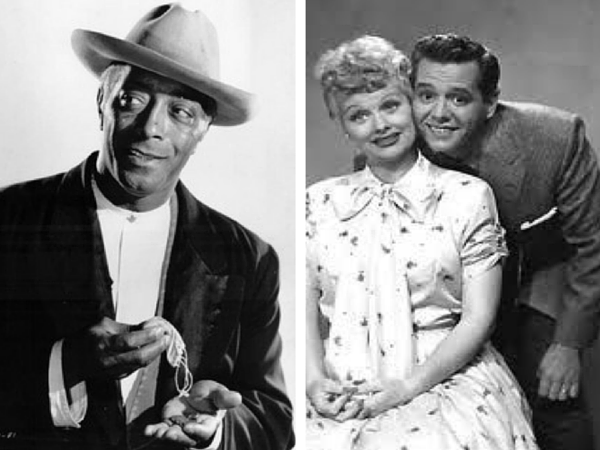

Juano Hernández (left) and Desi Arnaz with his wife Lucille Ball (right). Although they were both actors from the Hispanic Caribbean, Hernández and Arnaz were separated by race during the development of the United States film industry.
According to Jill Lane, blackface was used as a way to create a Cuban identity independent from Spain. However, one can argue that Blackness was seen as a proxy for national discourse and not for racial democracy. Anti-Blackness was occurring transnationally between the United States and Latin America. A Euro-diasporic anti-Black establishment was taking place, a cruel phenomenon, which can be traced back to colonialism and African slavery. Arnaz was able to perform White roles and even marry an Anglo-white actress, but the same could not be remotely fathomed for Hernández.
While many invoke the idea of mestizaje (racial mixing) and the one-drop rule, it did not determine Latin American identity racially. The false idea that you were non-White if any of your ancestors was not White has been a common belief that undergirded racial categories and Whiteness as passing in the United States. Regardless if Arnaz was considered White or not, his Whiteness allowed him to pass and have access to Hollywood. Arnaz benefited from the system of White Supremacy. While Arnaz was able to remain Cuban (while also being marginalized), Hernández was not able to be Puerto Rican because he was Black.
The impossibility of Afro descendants from Latin America being able to play Latin American (or Latino) roles would be further marked after the Civil Rights Movement. Black people from Latin America were segregated and became part of Black communities in the United Sates. Eminent figures like Arturo Alfonso Schomburg, Carlos Cooks, Chano Pozo and Mario Bauza among others formed part of the Harlem Renaissance. From the 1950s through the 1970s, there was a rise and fall of an uneasy coalition between Latinos and African-Americans. A part from the internal conflicts and White backlash that resulted from the Civil Rights Movement, the most salient aftermath was the cementing of racial essentialisms. Blackness was seen solely as African-American and Latinos became “Brown” while Whiteness became Anglo-whites. These political and racial constructions remained unquestioned until recently.
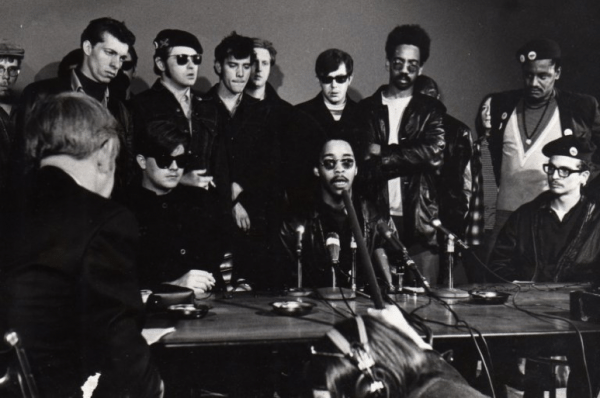

The rainbow coalition was an active coalition which consisted of many members such as Fred Hampton from the Black Panthers, William “Preacherman” Fesperan, Hy Thurman from the Young Patriots Organization, Jack (Junebug) Boykin, Jose Cha Cha Jimenez, the Puerto Rican founder of the Young Lords Party, among others.
The discussion of Latino Whiteness was rarely brought up and instead focused minimally on Latino Blackness. For example, Felipe Luciano’s “Jíbaro My Pretty Nigger” encouraged his Blackness and Puertoricaness.
It appears there was a time where you could be both Black and Latino but not White and Latino. The Nuyorican movement was occurring while the Black Arts Movements was taking place as well.
So the question remains: do Latinos “Brown” themselves to create Latino as a race because the racial discourse in the United States does not allow them to be a part of it? Another more important question is this: what occurred as a result of Latinos becoming one Brown (mixed) race and Blackness exclusive to African-Americans? As a result, Latin American markets and elites were able to carry out their anti-Black agendas, which led to the rise of all-White soap operas protected under the construction of mestizaje or Brownness. Afro-Latinos and Indigenous peoples were made either made invisible or reduced to adopting roles as musicians and sports athletes. This benefitted African-Americans tremendously because it allowed them to fully immerse themselves within American nationalism, which required separating their history from Latinos and Afro-Latinos while envisioning Latinos in the United States as people who were never part of the nation to begin with.
As Wilson Jeremiah Moses states in his book Black Messiahs and Uncle Toms (1982): “Black messianism is the point in our cultural mythology where nationalism and assimilationism come together most strikingly” (viii). African-American sitcoms resulted in Black essentialistist and racial hierarchies that excluded Afro-Latinos in the U.S and forced other Black migrants to assimilate to African Americanism. African-American sitcoms like “The Jeffersons,” “Sanford and Son” and “Good Times” were mostly Christian, monolingual and family-based. Latino sitcoms like “¿Qué Pasa USA?”, “Chico and the Man” and “A.E.S Hudson Street” were white, Christian, bilingual and also family-based.
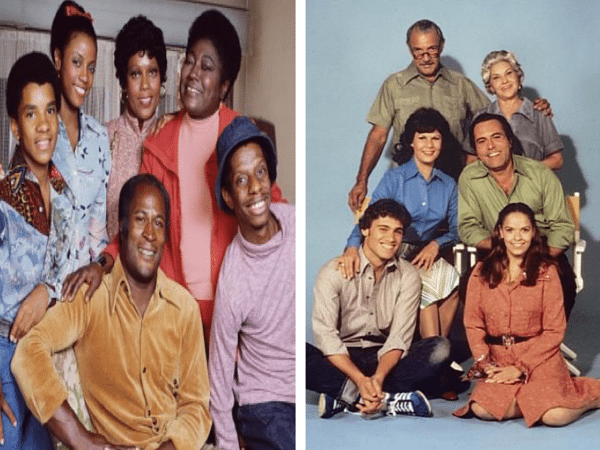

These racially and ethnically constructed divisions not only excluded the larger diverse Black communities in the U.S., but it also formed a Blackness antithetical to Latino identity. While Latin American markets created all-White soap operas (which has become ever more transnational) the U.S media also created these divisions. In Christina Saenz-Alcántara’s article Who and What the Hell Is a White Hispanic?, one of the many arguments presented is that Latino Whiteness is not possible because of the myths of mestizaje in some way makes Latinos all equal:
For example, in the U.S., there is the one-drop rule. If you have even one ancestor who is African, Asian, or indigenous, you’re automatically non-white. In Puerto Rico, the one-drop rule is that you are considered white if you have even one white ancestor in the previous four generations (known as the Regla del Sacar or Gracias al Sacar laws). In the U.S., a Latino historically is not white since Latinos by definition are a mixture of Spanish, indigenous, African and Asian blood.
However, according to the New York Times (see a counterargument here), in 2000 over 2.5 million Americans (numbers are more than likely higher now) changed their race from “some other race” to “White.”In the recent 2010 census, 75.8 % identified as White and 12.4 % identified as Black. Recently, because the Census Bureau finally realized that Latino is not a race, it is considering changing the ethno-racial category of “Hispanic” by allowing Latinos to choose a race for 2020. A recent document from the United States Census Bureau states that 1) three-fourths of growth in the White population was due to growing numbers of Hispanic Whites and, 2) Hispanic Whites comprised a larger proportion of the multiple White race population than the White-alone population.
So where does this leave us?
Today We are Paying the Price
The killing of Trayvon Martin by George Zimmerman caused many to revisit the notion of Latino Whiteness. The article published by Latino Rebels, The White Hispanic” Label: Yes, People, Racism is a Latino Thing, Too, actually made some good points at the need to revisit race and Latino identity, while Cesar Vargas’ The Privilege of the White Hispanic: Leaving Out the Rest caused, to my amazement, a stir from White Latinos. Nonetheless, we also need African-Americans to begin embracing Afro-Latinos among other Black communities who do not conform to an African American nomenclature. Unfortunately, as I had predicted, anti-Black racism has reached their doorstep. Rodner Figueroa compared Michelle Obama to a simian from the Planet of the Apes and was fired from Univision.
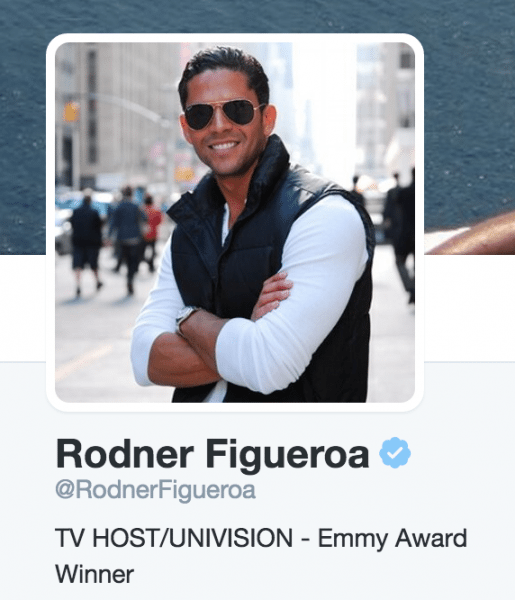

Figueroa’s excuse was that he was “mixed.” However, Univision, one of the most anti-Black television channels I’ve ever seen, made firing Figueroa seem like an oxymoron.
This Saturday, the Miss Puerto Rico winner for the Miss America pageant was suspended for anti-Muslim tweets.
Last night, the African-American actor Steve Harvey was attacked on Twitter from racist White Latinos (and other Latinos as well and Anglo-whites) who wanted Miss Colombia to win the Miss Universe contest. These profile used abhorrent language, as the tweets below show. All this hatred came as a result of Harvey mistakenly naming Miss Colombia the winner instead of Miss Philippines, the real winner.
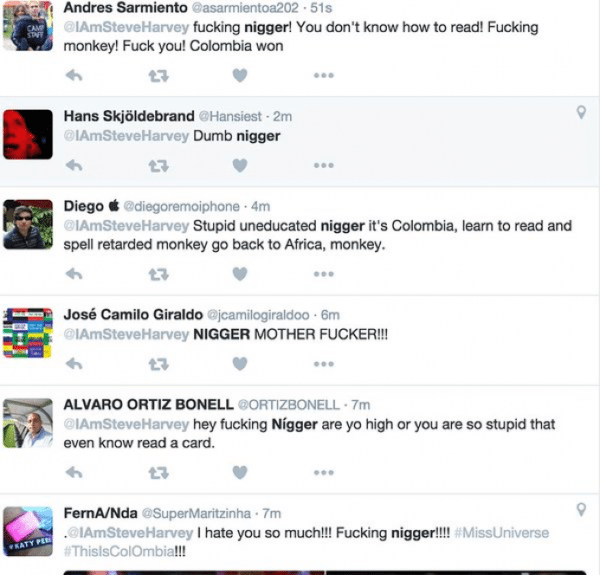

White Latinos need to own up to their Whiteness because we just can’t continue to afford this to continue any further. We also need African-Americans to understand that Latin America has over 200 million Afro-descendants and that going to Africa also entails going to Colombia, Brazil, Cuba and Puerto Rico, among other countries. Blackness does not have to solely mean African-American and Whiteness does not have to solely mean Anglo-white.
African-American academics need to stop erasing Afro-Latinos from African-American history.
They also have to become more open with Blackness.
They can’t wrap their Blackness with the American flag, exclude other Black people in the U.S and then say that they are all about Black unity.
History has made identity constructions that are reversible. We just have to work together and be honest about where we stand in the world.
***
William García is an Afro-Nuyorican raised between New York and Puerto Rico. He has a BA and an MA in history from the University of Puerto Rico-Rio Piedras. His research interests include Afro-Latino history, hip-hop and reggaetón in the Caribbean and Puerto Rican diaspora. He is currently an MA student in curriculum and teaching at the Teachers College at Columbia University in New York City. You can follow him on Twitter @webdubois2014.
EDITOR’S NOTE: An original version of this op-ed said that Zimmerman was of Jewish descent. He is not. A correction was made to one sentence.



I agree with much of what the author says… but I also think it falls far short in analysis because 75% of all “Hispanics/Latinos” in the U.S. are either Mexican or Central American… and the way this is framed, it is about a black-white society. Mexicans, Central Americans and people from the Andes are primarily Indigenous or Indigenous-based mestizos. De-Indigenization that more properly belongs in this discussion, especially when talking aboput the United States. Btw: the migra knows how to distinguish us, primarily due to our skin color… so to speak of whiteness for most of us, through a black-white prism, makes little sense. But I will stop here because this is what dissertations are about, not something that can be debated in a few hundred characters… but still, I do agree that the racism of this society infects everyone. No one is immune. And yes, much of it is distilled by White univision and telemundo — neither of which projects brown characters, just like they do not project black characters, except as the help, etc.
RobertoCintliRodriguez Thanks for posting your comments, Roberto! You are always welcome to write a longer piece if you like.
[…] White Latino Racism on the Rise: It’s Time for a Serious Conversation on Euro-Diasporic Whiteness […]
mestizo is a broad and undefined term which needs a lot of discussion because it simply means European and indigenous. Many mestizos can pass for white while many appear as indigenous. However, while many mestizos who benefit from who benefit from privilege can claim indigeneity darker indigenous mestizos cannot benefit from white privilege. If Ricky Ricardo would’ve been mestizo it wouldn’t change anything. If anything mentioning mestizos would’ve utterly strengthened my argument. I will next time.
Williamgarcia1987 This is not necessarily about or strictly about appearances… that’s why I mentioned the migra… they do not target black or white peoples. they target brown-skinned individuals… but this is beyond appearances. it is beyond black-white. Mestizo as you say is an imprecise term…it is not Indigenous-Spanish or Indigenous-European. More Blacks migrated to Mexico than Europeans. But again, your use of a black-white framework is inapplicable for most of us. Many of us are Indigenous or de-Indigenized Indigenous peoples. The black-whiteprism invisibilizes and silences most of us. Mexicans/Central Americans and peoples from the Andes in the U.S…. prob 80% of so-called Hispanics. The white Latinos are generally not coming from those countries… Part of the problem is that Hispanic//Latino is an artificial category. etc etc…
I’m not as interested in defining terms as I am in investigating who benefits from white privilege by passing. That has nothing to do with black-white binaries as your rationalization is clinging too. You sound smart and everything but it does very little to question my argument. Your giving a specific migra explanation, which is interesting but I’m obviously referring to racial hierarchies how’s in general. Not to mention that my argument is exploring racial hierarchies, white privilege and race theory from Latinos in the U.S. Latino is aade term but race has played a crucial role since before that term or Hispanic came into play, hence my op Ed. Just because analyzing this in the U.S. And focusing on blackness and whiteness doesn’t make it “incompatible”. Mestizos enjoy white privilege wether their in DF or in LA. Mestizo is not a monolithic term and not all mestizos look alike. Some can pass and hence we have to mention who their bodies occupies space in the U.S. Your arguments are weak with all due respect.
What are you saying here? Do you think that Latinos who are racist
against blacks or Indians or whoever do so because they identify as
white? Do you think that identifying as non-white is some kind of
antidote to racism?
Latinos:
The Indian Escape Hatch
By William Javier Nelson
http://racetraitor.org/nelson.html
Williamgarcia1987 I on the other hand don’t think your argument is weak at all.. I noted that I generally agree with your larger point – that there is definite racism amongst Latinos. what I am arguing is that mestizo is a colonially constructed term… One that de-indigenizes… And if you are talking about the entire continent or world, you make a better case… But in the u.s. , you argue through a blackwhite prism… which somewhat makes sense, but is incomplete. My argument is simple: a blackwhite prism is not the only way to view the world. And you mention that you are not interested in defining terms… well, how can you argue anything if the terms are undefined. For example, since when were Mexicans/Central Americans put into the government imposed: Hispanic category? The term itself de-Indigenizes and also, negates the African presence. The reason terms matter is because with it go many assumptions… btw… I am chocolate brown, with Afro-Indigenous background. I will stop there because I think writing here barely scratches… and it doesn’t stop the targeting of brown peoples by law enforcement, including the migrate.
RobertoCintliRodriguez Williamgarcia1987 What part of it doesn’t matter what prime I use can you not understand. If Paulina Rubio says she’s mestiza and the her grandmothers is indigenous it wouldn’t change her white privilege, either in DF or in the United States. she’s going to benefit from white supremacy no matter if I think through a black-white binary (which i don’t, its just a habitual rebuttal that deviates the main issue of white supremacy and identifying who benefits from white privilege) or understood the different racial hierarchies in Latin America. Instead of focusing on my prism focus on white supremacy and white privilege. Thats where we will unravel the issue that needs to get solved.
RobertoCintliRodriguez Williamgarcia1987 this is the last time I will reiterate and attempt to explain to you that it doesn’t matter what prism I use. If Paulina Rubio says that she is a mestiza or indigenous and that her grandmother is from a certain indigenous she would still enjoy white privilege and benefit from white supremacy. My “prism” wouldn’t affect her white privilege at all (if anything it would expose it). It doesn’t matter if I would look at race solely through a black-white binary (which i don’t. That’s just a habitual rebuttals that’s used as a deflection from focusing on who really benefits from white privilege and racial hierarchies) or from a more non-black white prism. This is the last time i will explain this. Instead of focusing on my supposed “prism” focus on white privilege amongst whites, mestizos, blacks whomever. Please stop writing frivolous comments and wasting my time. I understand your faulty logic. Thank you and have a nice day.
Williamgarcia1987 RobertoCintliRodriguez you don’t get to decide who uses weak or faulty logic…
It’s sad to see people arguing whether they are white or black. The fact is that there are only 4 races: white, black, red and yellow. In which category do you fall into? Whether you are dark or light has to do with the environment you move in. You adapt to the environment to survive. The colder the environment, the more white the pigment and the warmer the environment the darker the pigment. Your blood is still red no matter the color. Go back and study the Nomads, the Moors, etc. Today you have a mix everywhere because for survival we rely on man’s numerous inventions. What makes it bad for each race is temper, attitude and inferior complex. Each one is an example of who you are as an individual. Each one can progress or digress as an individual. Get rid of your fears, work hard and persevere with good intentions.
As an example look at the butterfly. A green butterfly lives within the green plants. The dark and grey on barks of trees and the more colorful shades are from the colorful flowers. Nature is the best example.
Yep, it is truly sad to have read the racist rant against Steve Harvey by so called white latinos. Three years ago, I taught French and Spanish at a high school that has 95% Mexicans, and most of them are illegals. I swear, I never experienced such hatred. Some of the students made my life very difficult. I will not mention here the things they said about me. Truly sad, that kind of behavior is encouraged at home by a group who should be thankful to have come to the United States, in search of a better life. At the end of the day we all have the same blood running through our veins. There’s no black, white, or brown blood!
[…] Garcia mentioned the fact that before Star Trek featured television’s first interracial kiss, people across […]
This is old but it centers around White black latino when in reality most of the latinos in the US are from Mexico and Central America which are vastly indio or heavily mestizo. I am from south America and here blacks are far more respected tan indians or mestizos.
Jokes such as a criolla naked is playboy material…. a Mexicana naked is national geographic material. (have in mind it makes allusion to the fact that criolla means White, while mexicans are supposed to be indians)
Che Guevara himself (A caucasian man from Argentina) was heavily prejudiced against the Indians, as he traveled through Bolivia he wrote in his memoirs that they were all ugly, smelly (refering to the indians or natives of Bolivia, the Aymara)
He is also famous for stating that most Mexicans are nothing but a bunch of illiterate indians. (obviously that excludes the mexican White minority)
So while the title resumes t White black…. the autor needs to understand the ENORMOUS racism towards the mestizo or indian which is what actually migrates the most to the US.
[…] is a deep-seated racism in Colombia, like in much of the hemisphere. Afro-Colombians suffer from systemic oppression, which often has violent repercussions, and from […]
This is kind of true. As a Puerto Rican who has pale skin, straight hair and a defined nose I fit in to South Carolina nicely. No one ever thinks I am Puerto Rican and I literally have to prove it by either a. speaking Spanish or b. showing them my full name lol. It’s kinda sad that people think that Puerto Ricans all look the same but whatever.
Erasing Afro latinos from African American History? If anything my mentors and teachers brought up Afro latinos everytime African American History was discussed. In my opinion, a lot of us have pushed Afro Latinos to the side because some iffy where they stand. There are times where even Afro Latinos that i have met will push racism under the rug like it doesn’t exist, Hell my wife is Puerto Rican, born and raised on the island and she doesn’t believe that there is racism on the island. We have been open to Blackness and including others in our perceive notions of Blackness, but you have to admit that hasn’t always work in Black American’s Favor.
It’s true, back in the 70’s it wasn’t but it is so true now, I see more racism from spanish/latin people of all kinds than I ever did from white people, so I no longer deal with any spanish, except for my black puerto rican ex husband, he also gets racism from other white looking spanish, and Puerto rican’s and he is Puerto Rican!!. So if I saw a spanish person in need of help, and I could help them, I wouldn’t help them at all, I see them now like I see racist white people!! so as far as I am concerned you can die!!
[…] it supposed to just be coincidence that nearly all holders of power in Latin America are white? And when we turn our eyes to the U.S.-ian shores —to the Latino leaders of industry in the […]
[…] and why centering whiteness is highly problematic, we recommend the following LR pieces from 2012, 2015, 2017 and 2020. These are just some of the many pieces we LR has published about a topic that […]
The MOST racist people I have ever met came from the White Hispanic community of Miami-dade , whether Cuban , Argentinean , Venezuelan or Colombian .
I was taken back by it as the Cubans I knew in NY , NJ were very nice and yes they warned me about the Miami junta .
I saw Cuban police in Miami treat darker Hispanics , Blacks with disdain while White Cubans for same minor traffic offense were treated with kid gloves .
[…] White Latino Racism on the Rise: It’s Time for a Serious Conversation on Euro-Diasporic Whiteness […]
[…] White Latino Racism on the Rise: It’s Time for a Serious Conversation on Euro-Diasporic Whiteness […]